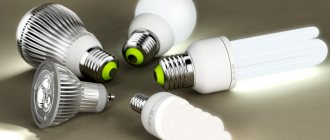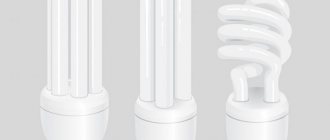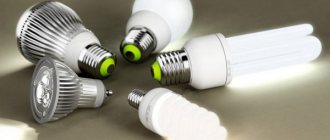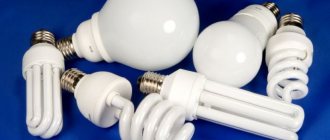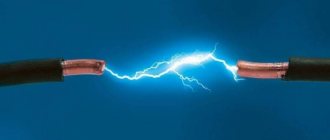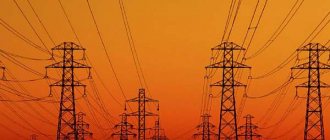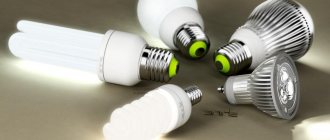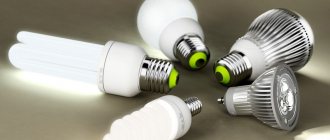Now LED lamps have become cheap and widespread. They are presented as the most energy efficient technology, but is this really so? Let's try to figure it out together with an expert.
Tariffs for housing and communal services, including electricity, are growing every year. Nowadays, Russians pay an average of 3 to 5 rubles for each kilowatt hour (and legal entities even more), so the issue of energy saving has been relevant for quite some time.
An ordinary incandescent lamp has a power of up to 100 watts - accordingly, for every 10 hours of burning it consumes one kilowatt hour. However, about 95% of this electrical energy is converted into heat
.
- halogen - the same incandescent lamps, but filled with a special gas. Due to this, more power can be supplied to the lamp and the coil can be heated to a higher temperature. As a result, the efficiency of the lamp increases, although not very significantly;
- gas-discharge lamps - well-known fluorescent lamps from the USSR in a more compact and modern form. They allow you to save a lot of energy, although they have quite a few disadvantages;
- LED lamps are currently the only truly energy-saving lighting option.
Gas-discharge (or fluorescent) lamps were popular more than 10 years ago, when the technological level did not yet allow placing all the components necessary for LEDs in the light bulb body.
The popularity of HID lamps in the past has brought problems in the present - they are more difficult to dispose of than any other light bulbs due to the presence of mercury.
Therefore, now the choice is almost clear - LED
lamps. There are so many of them on the market that it is difficult to choose an acceptable option. And there is plenty to choose from - an LED light bulb has several indicators that an incandescent lamp did not have and which not everyone knows about.
They affect both efficiency and human health.
Expert opinion
It-Technology, Electrical power and electronics specialist
Ask questions to the “Specialist for modernization of energy generation systems”
Which lamps are the most environmentally friendly? | EF-LIGHT company news And if the luminous flux is more of a conversation about saving, then the second and third indicators are directly related to human health. Ask, I'm in touch!
Lamp arrangement
Compact fluorescent lamps are often called energy-saving, but this is incorrect. Lighting the room with LEDs also significantly reduces electrical energy consumption. Let's consider the principles of operation of these two varieties.
Fluorescent lamps
An incandescent lamp emits light due to the action of an electrical discharge on a tungsten filament. Fluorescent light sources are tripled in a slightly different way: electricity passes through gas, due to which an ultraviolet glow is formed. Its rays cause the phosphor applied to the walls of the lighting device to shine. Mercury is used as a gas-forming substance.
Everyone knows that this element of the periodic table is dangerous for humans when evaporated.
In office premises, everyone is accustomed to seeing tube fluorescent fluorescent lamps. In order to protect people, they are filled not with mercury, but with its amalgam. If the lamp is damaged, then people staying indoors will not be at risk of poisoning from toxic fumes.
LED lamps
Unlike fluorescent lamps, LED lamps do not use substances containing mercury. These are the most environmentally friendly light sources. The LED lamp design includes a standard base, a board with LEDs and a driver for reducing the voltage in the network.
Such light sources can be considered completely safe, if not for one “but”: workmanship. Some manufacturers save on materials, in particular on plastic. In addition, sometimes lead, phenol and formaldehyde resins are used in the manufacture of LED lamps.
Harmful lighting and GOST
But as for the light itself from the light bulbs, as they say, there are nuances. First of all, this relates to the spectrum.
Not all spectra are equally useful.
The most harmful of them are blue and purple.
As the American proverb says, “Blue Light has a Dark side.”
The safe spectrum is green and red.
It is not for nothing that the red sun at dawn and sunset is considered very pleasant and beneficial for health. And yogis prefer to meditate at this time of day.
All degrees of harmfulness and risk of artificial lighting have long been calculated and described in GOSTs. Here is an excerpt from GOST R IEC 62471-2013 ().
The most dangerous are light bulbs with blue spectrum LEDs from 15W and above (3rd risk group).
Even most LED lamps for household use can easily be classified into the second group. This is explained by the fact that white LEDs also contain a blue component.
And only the good old incandescent light bulbs are deservedly considered the safest (zero and first categories).
Benefits of energy-saving lighting fixtures
Energy-saving light bulbs are popular because they have a number of advantages:
- long service life , provided that the light is not constantly turned on and off, and the device shines continuously for several hours;
- minimal energy costs - 80% less than a conventional incandescent lamp;
- long warranty period – up to 1 year;
- the lamp does not heat up during operation , which means it can be unscrewed immediately after turning off with bare hands.
What you need to know when choosing
Of course, there are still people who are happy to “rip the covers off” and prove that “energy saving” is a fiction, and only incandescent lamps “for 9 rubles from the market” provide real savings.
It was possible to agree with such arguments only at the dawn of the advent of energy-saving lamps, when for one device you had to pay 500-600, or even more rubles, and simple incandescent lamps really cost a penny.
Let’s assume that an incandescent lamp “for 9 rubles from the market” and a budget energy-saving lamp worked for the same period - 5000 hours. In absolute terms, this is a little more than 200 days, but if we take into account that the lamps do not burn around the clock but only at dusk and at night, we can consider this period equal to a year.
During this period, a 75-watt incandescent lamp “burned” 375 kilowatts. A similar fluorescent lamp with a power of 15 watts is only 75 kilowatts, and a LED lamp with a power of 7 watts is generally 35 kilowatts of electricity.
What does this mean in rubles? Let’s assume that the cost of a kilowatt of electricity is 3.7 rubles (the basic tariff for the Leningrad region in 2016, IChSH, tariffs are higher in St. Petersburg). In this case, an incandescent lamp will cost you 1,387.5 rubles per year, a fluorescent lamp will cost you 277.5 rubles, and an LED lamp will cost you 129.5 rubles. Already a noticeable difference, isn't it?
And finally, are you sure that a kilowatt will cost 3.7 rubles all year? Electricity tariffs are not at all characterized by a downward trend, but they can increase by a very noticeable amount, and the calculations above will become completely different.
| Incandescent lamp power, W | Similar fluorescent lamp power, W | Similar power of LED lamp, W |
| 35 | 7 | 3 |
| 40 | 8 | 4 |
| 45 | 9 | 5 |
| 60 | 11 | 8 |
| 65 | 13 | 9 |
| 75 | 15 | 10 |
| 90 | 18 | 12 |
| 100 | 20 | 14 |
| 125 | 25 | 16 |
| 130 | 26 | 17 |
| 150 | 30 | 18-20 |
| 225 | 45 | 25-30 |
Expert opinion
It-Technology, Electrical power and electronics specialist
Ask questions to the “Specialist for modernization of energy generation systems”
How to choose energy-saving lamps, and are there any savings? | LED lamps | Blog | DNS Club Among the types of lamps familiar to us, there are both completely environmentally friendly options and devices whose use should be limited. Ask, I'm in touch!
Harm from energy-saving lamps
As soon as energy-saving light bulbs appeared on store shelves, they immediately attracted the attention of consumers. Significant savings in electrical energy is a worthy argument in favor of such light sources, but there is also a downside to the coin. The harmful effects of fluorescent and LED lamps are as follows:
Electromagnetic radiation
The harm from it does not pose any danger to human life.
Nevertheless, experts say that if you count the number of constantly operating electrical appliances located in the room and add up all the indicators, you get an impressive figure.
If you compare a regular incandescent lamp and an energy-saving light bulb, the radio frequency field will be detected in the second one. This does not mean that such lamps cannot be used, but you should remember the following:
- It is not recommended to place an energy-saving lamp near a bed or screw it into a table lamp. Within a radius of 15 cm, the radiation intensity increases, so it is better to hang such lighting fixtures near the ceiling.
- A small electromagnetic field cannot result in a serious illness, but it is one of the risk factors. For diseases of the cardiovascular and nervous systems, it is better to limit such exposure.
- Doctors are sounding the alarm about the use of multiple points of light with energy-saving lamps in children's rooms and bedrooms. Even small amounts of radiation gradually suppress the immune system. As a result, chronic ailments worsen and the body's resistance to respiratory infections decreases.
Interference in the electrical network
As for fluorescent lighting fixtures, they are not designed to be constantly turned on and off.
At first, they were used to illuminate public places, where they burned continuously - only in this case, savings were ensured.
When an energy-saving lamp turns on, it puts an additional load on the power grid. The voltage begins to change with high intensity, which can lead to a short circuit and failure of several home appliances. This does not apply to LED lamps: when using them, the network is not “contaminated”.
Incorrect color rendering of energy-saving lamps can reduce visual acuity. The blue shades of LED light sources and the bright white color of fluorescent lamps distort perception and adversely affect the nervous system. When purchasing housekeepers, you should always pay attention to the manufacturer's rating. The lamp should emit a warm yellow color - then it is of high quality.
Mercury vapor
As mentioned earlier, there is a little mercury inside the fluorescent lamp - up to 5 mg. This dose is not lethal, but this amount of heavy metal can also cause poisoning if an energy-saving lamp breaks in a closed room. Mercury evaporates without any alarming odor, so a person can inhale toxic gases without suspecting anything.
In just a few minutes, the concentration of a toxic substance in the air exceeds the maximum permissible by 160 times! Therefore, if the lamp breaks, you must immediately open all the windows. In addition, it is better to try to collect the mercury in a jar of water or rinse the surfaces with a solution of potassium permanganate. If you managed to collect the mercury, then the jar needs to be tightly closed and taken to the sanitary station for disposal.
Recommendations
If you still want to use energy-saving lamps, then you need to make every effort to reduce the harm from their use. Remember a few simple rules:
- install lamps exclusively on ceilings, do not use them in bedside lamps or table lamps, the distance to it is at least one meter;
- in case of mechanical damage, immediately ventilate the room;
- put on rubber gloves and use your hands to collect the fragments with drops of mercury (the latter can be collected using a pipette);
- no need to use a broom or vacuum cleaner for this purpose;
- then perform wet cleaning;
- place the rag with mercury and the fragments in a sealed bag;
- Disposal occurs in specially designated areas for toxic waste.
We believe that the danger of energy-saving lamps affecting human health is more than real. But a few simple recommendations, your vigilance, adherence to operating dates and no attempts to save money on the purchase of such products significantly reduce the risk of developing diseases.
Disposal of energy-saving lamps
After the lamp has served its useful life, it must be disposed of. What to do if it burns out? It all depends on its type.
- LED light bulbs do not pose any danger to the environment and human health, so if such a device burns out, it can be thrown into the trash. However, it will be more useful to collect such waste and hand it over as recyclable materials.
- Fluorescent lamps contain mercury, so they should not be thrown away. Of course, the majority neglects this rule, and one can only guess how such negligence affects the ecological state of the planet. The used lighting device must be taken to the regional department of DEZ, where they know how to properly dispose of it.
District DEZ may refuse to accept such waste. In this case, you have to look for a company that recycles lamps and pay for its services.
Therefore, when purchasing a fluorescent lamp, you should immediately expect that it will have to be disposed of.
Advice from professionals
Considering that mercury poses a danger to the environment and human health, fluorescent lamps are significantly inferior to LEDs and halogen lamps. Even in European countries, mercury thermometers have long been discontinued. So why take the risk and use fluorescent lamps?
Professionals believe that such lighting devices do not deserve attention, and the only purpose of their creation is a smooth transition from incandescent lamps to LED lamps.
Indeed, the service life of LEDs does not depend on the number of times they are turned on and off; there is no need to wait until the lamp warms up and begins to shine brighter, and they can be disposed of along with other solid waste. High-quality products have the correct color temperature and do not create eye strain.
So, we have learned that not only a compact tubular fluorescent lamp can be called energy-saving.
Currently, it has worthy competitors in this field - LED and halogen lighting devices.
Not so long ago, not everyone could afford to purchase an LED lamp, but today their prices have been reduced and are acceptable to everyone. In addition, the energy savings and long service life quickly pay for the cost of the lamp. Fluorescent lamps are a good option for lighting offices, but for the home it is better to opt for LEDs.
Myth number two
Let's move on to the next reason why it is believed that the use of energy-saving lamps is harmful to human health, and specifically to the eyes. We need to start refuting this myth with the fluorescent lamps themselves, or, more precisely, with their old samples.
The design of linear fluorescent sources includes the so-called electromagnetic ballast or ballast. It includes: capacitors, a choke and a starter. It is through the ballast that the lamp is connected to the electrical network. And it is this device that changes the luminous flux over time. That is, pulsation occurs within 100 blinks per second. The human eye does not notice this pulsation, but if you stay for a long time in a room where old-style fluorescent lamps are installed, this will be felt as a decrease in the performance of the person himself, as a loss of his strength.
In the design of energy-saving lamps, an electronic ballast or electronic ballast is installed. This device regulates voltage, eliminating light pulsation.
Attention! Energy-saving fluorescent lamps with an E14 or E27 base include electronic ballasts, which are built into the base itself. Pin lamps of this type also have electronic ballasts in their design, only it is built into the lamp bulb.
Please note that two-pin devices can only operate from electromagnetic ballasts, four-pin devices from both ballasts and electronic ballasts. Therefore, before purchasing a lamp of this type, read the information regarding the ballast installed in it.
And one more point regarding harm to the eyes. Energy-saving lamps emit diffused light that is not too tiring for the eyes. In addition, such lighting is considered more comfortable and less contrasting.
